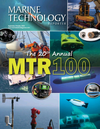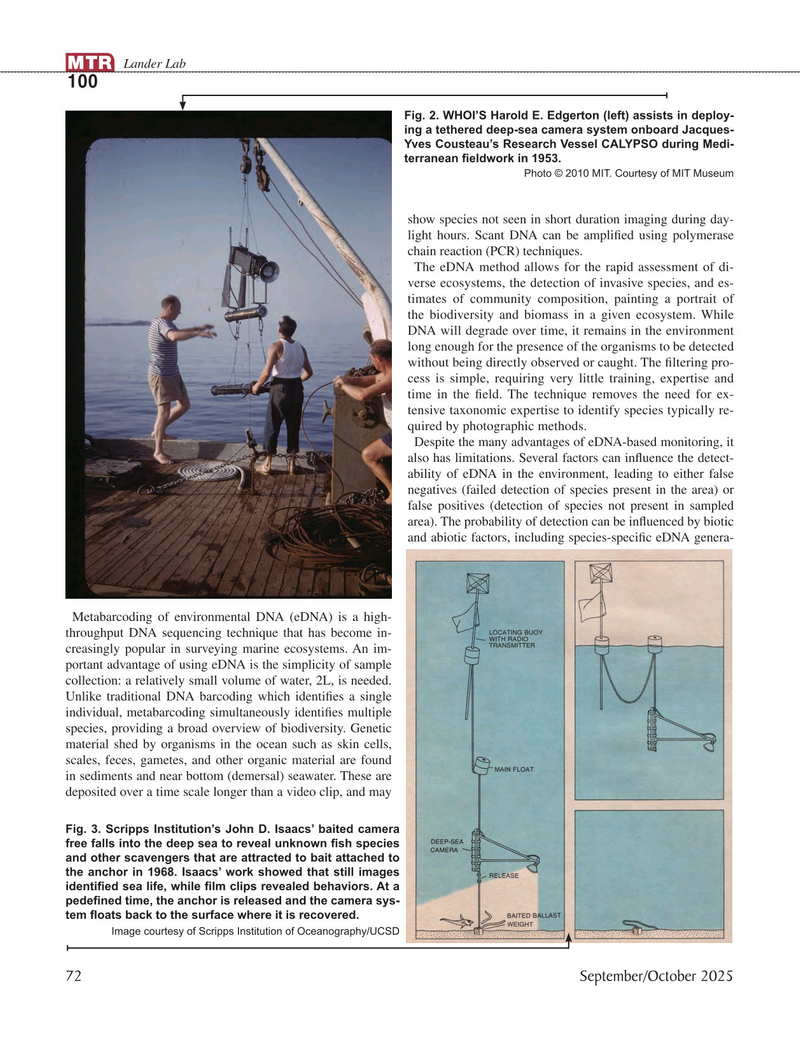
Page 72: of Marine Technology Magazine (September 2025)
Read this page in Pdf, Flash or Html5 edition of September 2025 Marine Technology Magazine
Lander Lab
MTR 100
Fig. 2. WHOI’S Harold E. Edgerton (left) assists in deploy- ing a tethered deep-sea camera system onboard Jacques-
Yves Cousteau’s Research Vessel CALYPSO during Medi- terranean ? eldwork in 1953.
Photo © 2010 MIT. Courtesy of MIT Museum show species not seen in short duration imaging during day- light hours. Scant DNA can be ampli? ed using polymerase chain reaction (PCR) techniques.
The eDNA method allows for the rapid assessment of di- verse ecosystems, the detection of invasive species, and es- timates of community composition, painting a portrait of the biodiversity and biomass in a given ecosystem. While
DNA will degrade over time, it remains in the environment long enough for the presence of the organisms to be detected without being directly observed or caught. The ? ltering pro- cess is simple, requiring very little training, expertise and time in the ? eld. The technique removes the need for ex- tensive taxonomic expertise to identify species typically re- quired by photographic methods.
Despite the many advantages of eDNA-based monitoring, it also has limitations. Several factors can in? uence the detect- ability of eDNA in the environment, leading to either false negatives (failed detection of species present in the area) or false positives (detection of species not present in sampled area). The probability of detection can be in? uenced by biotic and abiotic factors, including species-speci? c eDNA genera-
Metabarcoding of environmental DNA (eDNA) is a high- throughput DNA sequencing technique that has become in- creasingly popular in surveying marine ecosystems. An im- portant advantage of using eDNA is the simplicity of sample collection: a relatively small volume of water, 2L, is needed.
Unlike traditional DNA barcoding which identi? es a single individual, metabarcoding simultaneously identi? es multiple species, providing a broad overview of biodiversity. Genetic material shed by organisms in the ocean such as skin cells, scales, feces, gametes, and other organic material are found in sediments and near bottom (demersal) seawater. These are deposited over a time scale longer than a video clip, and may
Fig. 3. Scripps Institution’s John D. Isaacs’ baited camera free falls into the deep sea to reveal unknown ? sh species and other scavengers that are attracted to bait attached to the anchor in 1968. Isaacs’ work showed that still images identi? ed sea life, while ? lm clips revealed behaviors. At a pede? ned time, the anchor is released and the camera sys- tem ? oats back to the surface where it is recovered.
Image courtesy of Scripps Institution of Oceanography/UCSD 72 September/October 2025
MTR #7 (66-79).indd 72 MTR #7 (66-79).indd 72 10/8/2025 3:51:19 PM10/8/2025 3:51:19 PM

 71
71

 73
73
